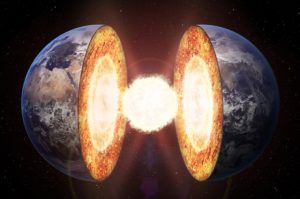In a lot of ways the earth’s inner core remains a mystery. Mostly it’s because it is so hard to investigate. It’s over 6,300 kilometers (about 4,000 miles) away.
Humanity has been able to drill only 12 kilometers (7.5 miles) of that. Seismologists of yore used sound waves during earthquakes to determine the physical property of the core. The age is a hard thing to gauge. So far the estimates are 2 billion to a mere 0.5 billion years old.
It was at least narrowed down today when a University of Liverpool team of researchers led by the University of Liverpool revealed that the age of the inner core is somewhere between 1 and 1.5 billion years old. The study is published in Nature.
This is the deepest layer of our planet. The ability to asses the types of sound waves that do or do not travel through the core has helped scientist to work out that it is mostly composed of iron and nickel. They have even determined that the sphere is slightly larger that Pluto (a diameter of 2,440 kilometers or 1,500 miles).
The static inner core’s interaction with the swirling outer core generates the Earth’s magnetic field, and protects life from dangerous levels of solar radiation. The study of the “Iron catastrophe”, when the core was formed, could enlighten scientists as to when this stable, protective magnetic field began to be generated. If indeed the inner core formed around 1 to 1.5 billion years ago as the authors suggest, then this would coincide with the rise of simple multi-cellular life on Earth, such as red algae, approximately 900 million years ago.

